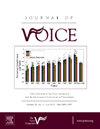Voice Disorder Classifications: A Scoping Review – Part A
IF 2.5
4区 医学
Q1 AUDIOLOGY & SPEECH-LANGUAGE PATHOLOGY
引用次数: 0
Abstract
Voice is a complex and multidimensional phenomenon of interest to different disciplines. Divergent terminologies and, consequently, classification systems constitute, historically, a difficulty in this field of knowledge, which limits communication between professionals from different countries, backgrounds, and clinical experiences, and well as limiting clinical management and discussion of scientific research findings. This article aims to map and analyze the different diagnostic classifications in voice by describing the findings of a scoping review, consisting of both electronic and manual searches. The results are presented in two parts. In Part A of this article, we explore propositions for comprehensive diagnostic classifications, which involve theoretical frameworks for the constitution of each proposal. The included studies were classified as either articles with theoretical propositions, called G1, or articles using automated computerized classification systems called G2. A total of 44 articles were included: 27 in G1 and 17 in G2. In G1, we found studies from 1947 to 2021, most of which were from the USA, the authors having created theoretical propositions on the subject, considering mainly the etiology of vocal disorder. In G2, we found studies from 2009 onwards, emphasizing automated extraction of acoustic measurements and machine learning to create classification systems. G1 shows the propositions of classifications ranging from two to 11 main groups, each with possible subgroups. In G2, the classifications ranged from four to seven groups, showing preference to distinguish them by descriptions of laryngeal conditions. Conclusion: There is limited convergence between the different theoretical classifications, which is highlighted by the need to create different subgroups, or categories, to include different vocal disorders. The studies with a computerized approach reduce this variability to a certain extent; however, although promising, they should consider theoretical foundations in the proposition of classifications to be applicable to clinical setting.
嗓音障碍分类:范围审查--A 部分。
嗓音是一个复杂的多维现象,受到不同学科的关注。不同的术语和分类系统历来是这一知识领域的难点,限制了来自不同国家、背景和临床经验的专业人员之间的交流,也限制了临床管理和科研成果的讨论。本文旨在通过描述一项范围界定审查的结果(包括电子和人工搜索)来绘制和分析嗓音的不同诊断分类。研究结果分为两部分。在文章的 A 部分,我们探讨了综合诊断分类的命题,其中涉及构成每个命题的理论框架。所纳入的研究被分为两类,一类是有理论命题的文章,称为 G1;另一类是使用计算机自动分类系统的文章,称为 G2。共纳入 44 篇文章:其中 27 篇属于 G1,17 篇属于 G2。在 G1 中,我们发现了从 1947 年到 2021 年的研究,其中大部分来自美国,作者就这一主题提出了理论主张,主要考虑了声乐障碍的病因。在 G2 中,我们发现了 2009 年以后的研究,强调声学测量的自动提取和机器学习以创建分类系统。G1 显示了从 2 到 11 个主要类别的分类主张,每个类别都有可能的子类别。在 G2 中,分类范围从 4 到 7 组不等,显示出更倾向于通过喉部条件的描述来区分它们。结论:不同理论分类之间的趋同性有限,这突出表现在需要创建不同的分组或类别,以包括不同的声带疾病。采用计算机化方法进行的研究在一定程度上减少了这种差异;然而,尽管前景光明,但这些研究在提出适用于临床的分类时应考虑到理论基础。
本文章由计算机程序翻译,如有差异,请以英文原文为准。
求助全文
约1分钟内获得全文
求助全文
来源期刊

Journal of Voice
医学-耳鼻喉科学
CiteScore
4.00
自引率
13.60%
发文量
395
审稿时长
59 days
期刊介绍:
The Journal of Voice is widely regarded as the world''s premiere journal for voice medicine and research. This peer-reviewed publication is listed in Index Medicus and is indexed by the Institute for Scientific Information. The journal contains articles written by experts throughout the world on all topics in voice sciences, voice medicine and surgery, and speech-language pathologists'' management of voice-related problems. The journal includes clinical articles, clinical research, and laboratory research. Members of the Foundation receive the journal as a benefit of membership.
 求助内容:
求助内容: 应助结果提醒方式:
应助结果提醒方式:


